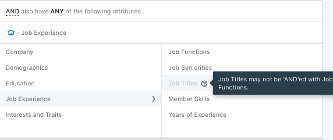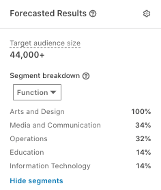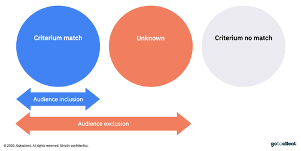How to build an optimal LinkedIn Ads targeting strategy
LinkedIn Ads is recognized for its targeting segmentation tool, because it has one of the most complete audience segmentations compared to other platforms such as Google Ads or Facebook Ads. To build an optimal segmentation strategy on LinkedIn Ads, you must first know all the platform’s options. Then, it is essential to take into account best practices to segment your audience effectively. In this post, we explain it!

Also, according to LinkedIn, 4 out of 5 users make business decisions based on the information they get from LinkedIn. Down below, we are going to show you how to To build an optimal segmentation strategy on LinkedIn Ads
Company
–Company name: Your team can impact company members you consider relevant to your campaign.
–Company industry: Companies industry you want to show the ad.
–Company size Based on the employees’ number listed on the company page.
–Company followers: Filtered by the followers’ number the companies have.
–Company connections: First-degree connection of employees at the companies your team select.
Demographics
–Member age: Derived by member profile.
–Member gender: Derived from member age.
Education
–Field of study: It’s allowed to segment by users’ studies.
–Degrees: The same as field of study.
–Member schools: Your company can select schools in order to impact their members.
Job experience
–Job title: Standardized information related to the job title introduced by the member.
-Job seniority: Derived from the job title.
-Job function: Derived from job function. It’s important to take into account the job title option is not compatible with job seniority and job function options.
–Years of experience: Years of professional experience accumulate over their career.
–Members skills: Based on skills, endorsements and keywords in profile.
Interests
–Member groups: Specific LinkedIn’s groups your target audience member has joined.
-Interest-based: Option based on the user’s interests indicated in their profile.
–Custom segments: Available only by an Account team.

After explaining the different segmentation options that LinkedIn offers, why we’re going to give your team some key tips & tricks in order to impact the right users. It’s essential to analyze the target audience and know how to introduce the target attributes on the LinkedIn Ads segmentation tool
Company industry and size
Those options are the most used criteria because it’s basic information both to know and indicate. On the one hand, it’s key to select industries your team wants to impact because it’s no common that companies address all markets. On the other hand, maybe your company is not interested to impact companies with few employees (for example myself only or 2 to 10 employees), or, conversely, with many workers (+10,001 employees).
Targeting max 3 audience specs
It’s important not to add more than 4 attributes on the segmentation, otherwise, the audience will be very limited.
Exclude audiences
In order to succeed in your campaigns, it’s also important to exclude the audience you don’t want to impact. Your company can exclude whatever they want: company names, company sizes, job function, job title, job seniority, and so on. It’s a good practice to exclude the audience because it’s better to specify which audience you want to impact and which not.

Members skills for a target with specific features
In case your target has specific features, it’s difficult to determine it through the segmentation tool. That’s why we recommend adding some member skills in order to specify how your target audience is. Consequently, the ad will be consumed by the right users.
Job function and seniorities are not suitable with a job title
Before segmenting the target audience, it’s important to take into account job function and job seniority are not suitable with a job title. Therefore, if the target is very specific, we recommend to segment through the job title, and if not, by job function and job seniority.

Entry-level for small companies
Another optimal LinkedIn Ads targeting strategy is about the entry-level option. If your team wants to target through the job seniority, the entry-level option it’s adequate for small companies.
Take out audience expansion
This option expands beyond the desired target, so it’s important not choosing it.

CRM integration
LinkedIn allows integrating a CRM in order to arrive at specific companies and users you want to impact. This activity can be done through Markto, Dynamics, Salesforce and Hubspot.
Pixel integration in page
A good practice is also to integrate with the pixel on the page to impact the website audience. This way, your ad will reach users who were previously interested in your company. This is an optimal LinkedIn Ads targeting strategy that must be understood and considered in the campaign.
Verify your company are performing a good segmentation through Forecast results
When you start adding filters, the audience’s results will appear on the right side of the screen in order to analyze if you’re doing it correctly. In addition, when the campaign is launched, your team can check if the right audience is being impacted, and if not, filters can be modified.

Retargeting
After launching the campaign, your team can carry out a retargeting campaign with those users who have clicked on the ad, but they didn’t fill out the form. Consequently, you will impact those users who were interested in the ad and increase the chances they will submit the form.
A/B testing 100% recommended
We definitely recommend making an A/B testing to analyze which target audience segmentation reach optimal users.
And & Or connectors
An OR connector means the user only has to fulfil one of the conditions stipulated to be included on the campaign. Concerning the AND connector, the target will need to comply with all the selected attributes, otherwise, it will be excluded from the campaign. Consequently, through the connector ANDthe audience members are more reduced but concrete. In addition, when audience is small, we need to enlarge it with OR to functions.
Include vs exclude members
The latest optimal LinkedIn Ads targeting strategy is about inclusions and exclusions. In some cases, it’s better to exclude than to include attributes because some companies don’t indicate some attributes in their company profile. Consequently, members of these companies will be excluded from the campaign.

After showing you the LinkedIn’s segmentation options along with our tips & tricks based on extensive experience, you will be able to develop an optimal segmentation strategy.

